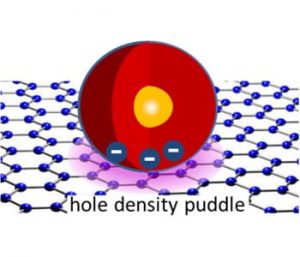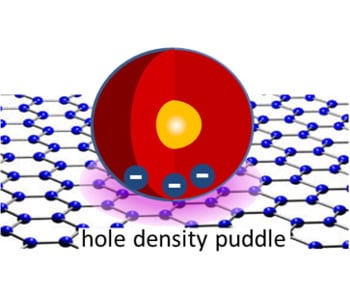 Coupling two distinct nanostructures often leads to a new class of hybrid material with unique properties and functionalities. On the other hand, it could produce worthless hybrids, as one nanostructure could neutralize the useful properties of the other.
Coupling two distinct nanostructures often leads to a new class of hybrid material with unique properties and functionalities. On the other hand, it could produce worthless hybrids, as one nanostructure could neutralize the useful properties of the other.
Graphene, an atomically thin sheet of carbon, exhibits unique electrical and optical properties that are highly beneficial for a wide range of electronic, optoelectronic, and photovoltaic applications. Semiconductor nanocrystals (NCs) that exhibit exceptional optical properties derived from 3D quantum confinement of their charge carriers (i.e., electrons and holes), have also inspired many applications spanning from biomedical imaging to solid state lighting and quantum communication. When NCs are coupled to graphene, excitons (i.e., electron–hole pairs) created in the NCs by the absorption of light can recombine nonradiatively, subsequently transferring their energy to graphene via near-field interactions (i.e, Förster energy transfer). As a result, the NC’s photoluminescence (PL) is quenched strongly. While such an effect may be useful for energy harvesting and sensing applications, it neutralizes the exceptional light emission properties of the NCs and therefore severely inhibits the use of NC–graphene hybrid systems in applications such as light-emitting diodes, lasers, and as single photon sources.
In contrast to the above scenario, scientists from the Center for Integrated Nanotechnologies, Los Alamos National Laboratory, show that when a new class of nanocrystals called giant-NQDs (g-NQDs) are coupled to graphene, bi-excitons (BX), i.e., pairs of excitons, optically excited in g-NQDs, experience efficient recombination and subsequent simultaneous emission of photon pairs. A joint effort with scientists from the Theoretical Division, (Los Alamos National Laboratory) resulted in a model providing an insight into this interesting phenomenon. The model predicts the formation of excess charge density, named a ‘charge puddle’, within the graphene sheet right underneath a photocharged g-NQD. In this case, the g-NQD acts as a gate electrode, controlling the amount of charge in the puddle. Collective oscillations of the puddle’s charges results in a new localized plasmon mode interacting with the excitons and bi-excitons of the g-NQD. This interaction gives rise to the observed enhancement in photon emission.
These findings reveal a tremendous potential for graphene-g-NQD hybrids in applications requiring highly efficient single-photon and photon-pair emission, including lasing and entangled photon sources. The discovery of a new plasmon mode also has several important implications in the fields of plasmonics, photonics, and quantum optics. Specifically, extending the tunability of graphene plasmon modes to the visible spectral range should dramatically expand the optical functionality of graphene plasmonics. Furthermore, the formation of this new plasmon mode directly underneath the g-NQD provides a perfect solution to the general problem of quantum emitter–plasmonic cavity alignment hindering a realization of strong plasmon–exciton coupling. Access to such a coupling regime may ultimately open a new route towards quantum plasmonics.

















